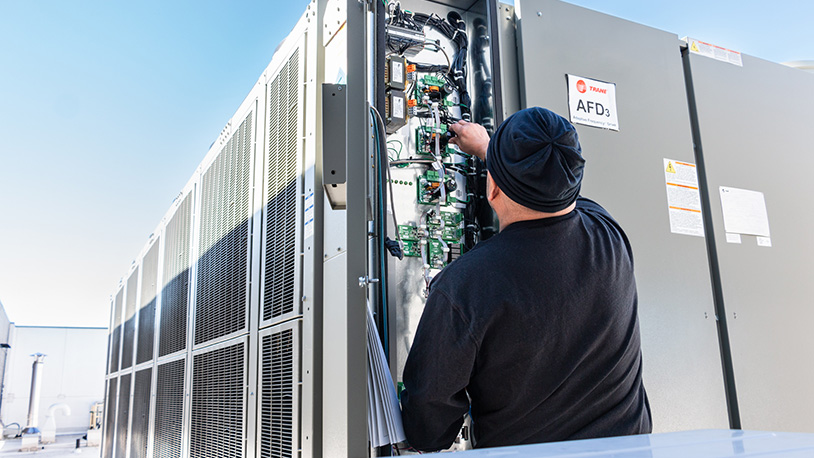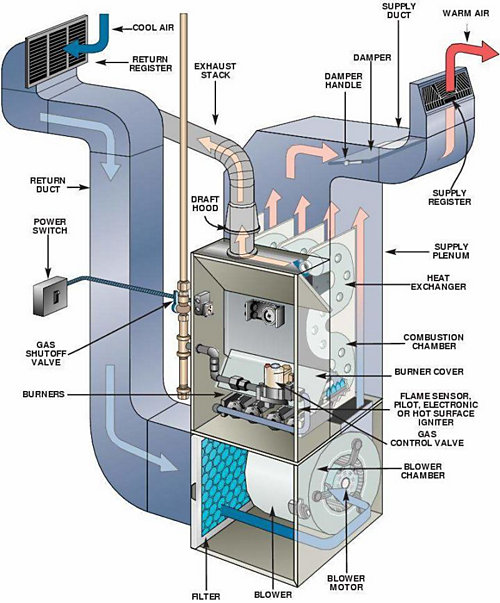Discover how HVAC experts support commercial facility comfort needs
Checking Out the Necessary Elements of a Reliable HVAC System
An efficient heating and cooling system is developed on a number of important elements that function in harmony. Each part, from the thermostat to the ductwork, plays a necessary function in preserving comfort and energy efficiency. Recognizing these components is critical for maximizing efficiency and improving indoor air quality. As one examines these components, the detailed partnerships between them reveal understandings right into enhancing general system efficiency. What certain variables add most to this effectiveness?
The Role of the Thermostat in A/c Effectiveness
Often forgotten, the thermostat plays an important role in the performance of A/c systems. This small tool serves as the primary control facility, regulating temperature level settings and making certain suitable comfort within a room. By accurately picking up the ambient temperature, the thermostat connects with the air, heating, and air flow conditioning systems to keep the preferred climate
An efficient thermostat lessens energy usage by triggering the HVAC system only when needed, therefore preventing extreme home heating or air conditioning. Modern smart and programmable thermostats improve this effectiveness even more by permitting individuals to establish schedules and remotely adjust settings, adjusting to everyday routines.
Furthermore, the positioning of the thermostat is crucial; incorrect place can result in inaccurate temperature readings, causing ineffective procedure. On the whole, a well-functioning thermostat not just improves comfort but also contributes significantly to energy financial savings and the longevity of the cooling and heating system.
Recognizing the Relevance of Air Filters
Air filters offer a necessary function in heating and cooling systems by guaranteeing that the air circulating within a room stays healthy and balanced and tidy. These filters trap dirt, irritants, and other pollutants, stopping them from being recirculated throughout the atmosphere. By capturing these fragments, air filters add to enhanced interior air quality, which can greatly benefit passengers' health and wellness, particularly those with allergic reactions or respiratory system problems.
In addition, maintaining tidy air filters improves the efficiency of heating and cooling systems. Clogged filters can limit airflow, creating the system to work more challenging to keep wanted temperatures, causing enhanced energy consumption and greater energy bills. Frequently changing or cleansing filters is a vital maintenance step that can lengthen the lifespan of cooling and heating tools. Inevitably, comprehending the relevance of air filters enables home owners and building managers to take positive steps to assure a well-functioning, effective cooling and heating system that advertises a comfortable and risk-free indoor atmosphere.

The Functionality of the Furnace and Warmth Pump
Furnaces and heatpump are crucial parts of heating and cooling systems, responsible for offering heat throughout chillier months. Heaters run by heating air with burning or electric resistance, after that distributing it throughout the home using ducts. They usually supply rapid heating and can be sustained by gas, electricity, or oil, depending upon the system kind.
Alternatively, heat pumps transfer warm rather than generate it. They extract heat from the outside air or ground, even in low temperature levels, and move it inside. HVAC experts. This double capability permits heatpump to also supply air conditioning in warmer months, making them functional alternatives for year-round environment control
Both systems require correct maintenance to guarantee effectiveness and durability. While heating systems succeed in severe cool, warmth pumps can be useful in modest climates. Understanding their unique functionalities aids property owners in selecting one of the most suitable option for their heating needs.
Discovering the Cooling Device
The cooling device is an essential part of cooling and heating systems, readily available in numerous kinds to fit different needs. Recognizing the performance rankings of these systems is vital for making notified options about power intake and expense. This section will certainly discover the varied kinds of air conditioners and make clear exactly how effectiveness ratings influence efficiency.
Sorts Of Air Conditioners
While different factors affect the option of air conditioning systems, recognizing the various types readily available is vital for house owners and building supervisors alike. Central air conditioners are designed to cool down entire homes or structures, directory utilizing a network of air ducts for air flow. Home window systems offer an even more localized option, ideal for solitary rooms or little spaces. Portable air conditioning unit provide versatility, allowing individuals to move the system as required. Ductless mini-split systems are one more alternative, combining the performance of central systems with the ease of zoning, as they need no ductwork. Ultimately, geothermal systems harness the earth's temperature level for energy-efficient air conditioning. Each type comes with distinctive advantages, making notified selections vital for reliable climate control.

Effectiveness Ratings Explained
Comprehending performance scores is crucial for choosing the appropriate a/c device, as these metrics offer understanding right into the system's performance and power intake. The most typical ranking for a/c unit is the Seasonal Power Efficiency Ratio (SEER), which determines the cooling result during a regular cooling season separated by the total electrical power input. A greater SEER indicates much better effectiveness. In addition, the Power Efficiency Ratio (EER) is utilized for measuring performance under specific conditions. An additional vital metric is the Power Star qualification, which symbolizes that a system fulfills rigorous power efficiency guidelines. By assessing these scores, customers can make enlightened selections that not just maximize convenience yet additionally reduce energy costs and environmental impact.
The Significance of Ductwork and Airflow
Effective ductwork design and air movement monitoring play essential functions in the overall efficiency and performance of heating and cooling systems. Appropriate ductwork assurances that conditioned air is distributed evenly throughout a room, decreasing temperature level changes and improving comfort. Well-designed ducts decrease resistance to air movement, minimizing the workload on heating and cooling equipment and ultimately decreasing power usage.
Airflow management includes strategically positioning vents and signs up to improve the flow of air. This protects against usual problems such as chilly or hot places, which can happen when air flow is blocked or inadequately balanced. Additionally, the right air duct materials and insulation can further boost effectiveness by find more info decreasing warmth loss or gain throughout air transit.
A reliable ductwork system not only adds to energy savings yet can also lengthen the life expectancy of HVAC tools by decreasing unneeded stress (HVAC experts). Understanding the value of ductwork and air flow is essential for accomplishing peak HVAC system efficiency.
Regular Maintenance Practices to Boost Performance
Routine upkeep practices are necessary for ensuring peak efficiency of heating and cooling systems. These methods consist of routine assessments, cleansing, and required repair services to maintain the system running efficiently. Consistently changing air filters is important, as clogged up filters can block airflow and decrease effectiveness. Additionally, specialists must examine and tidy evaporator and condenser coils to avoid overheating and energy waste.
Yearly specialist examinations are also recommended, as trained specialists can recognize potential issues before they intensify. Lubing moving components lessens damage, adding to a much longer life-span for the system. Guaranteeing that the thermostat works appropriately help in maintaining perfect temperature control.
Often Asked Inquiries
Just how Often Should I Replace My Thermostat?
Thermostats should usually be replaced every 5 to ten years, depending upon use and innovation improvements. Normal checks are suggested to assure peak efficiency, specifically if experiencing irregular temperature level control or boosted power expenses.
What Size Air Filter Is Finest for My Heating And Cooling System?
The finest size air filter for a heating and cooling system varies by unit style. Usually, it's crucial to seek advice from the owner's handbook or inspect the existing filter dimensions to ensure peak performance and air top quality.
Can I Set Up a Warm Pump Myself?
Setting up a heatpump independently is possible for proficient people, but it requires expertise of electrical systems and local codes. Hiring a professional is advised to ensure proper installment and suitable system performance.
Just how Do I Know if My Ductwork Is Effective?
To identify ductwork performance, one must look for leakages, step airflow at vents, Related Site evaluate insulation high quality, and review temperature differences in between supply and return ducts. Expert assessments can give extensive insights right into overall efficiency.
What Are Indications My HVAC Demands Immediate Upkeep?
Signs that a heating and cooling system needs immediate upkeep include uncommon noises, irregular temperatures, raised energy expenses, unpleasant odors, and constant cycling. Resolving these issues without delay can avoid more damage and warranty height system performance.
Air filters offer an important feature in HVAC systems by assuring that the air distributing within a room stays clean and healthy and balanced. Furthermore, maintaining clean air filters boosts the effectiveness of Cooling and heating systems. Ductless mini-split systems are another alternative, incorporating the efficiency of central systems with the ease of zoning, as they need no ductwork. Understanding performance rankings is vital for picking the right air conditioning device, as these metrics give insight into the system's performance and power usage. The ideal dimension air filter for a HVAC system varies by unit design.